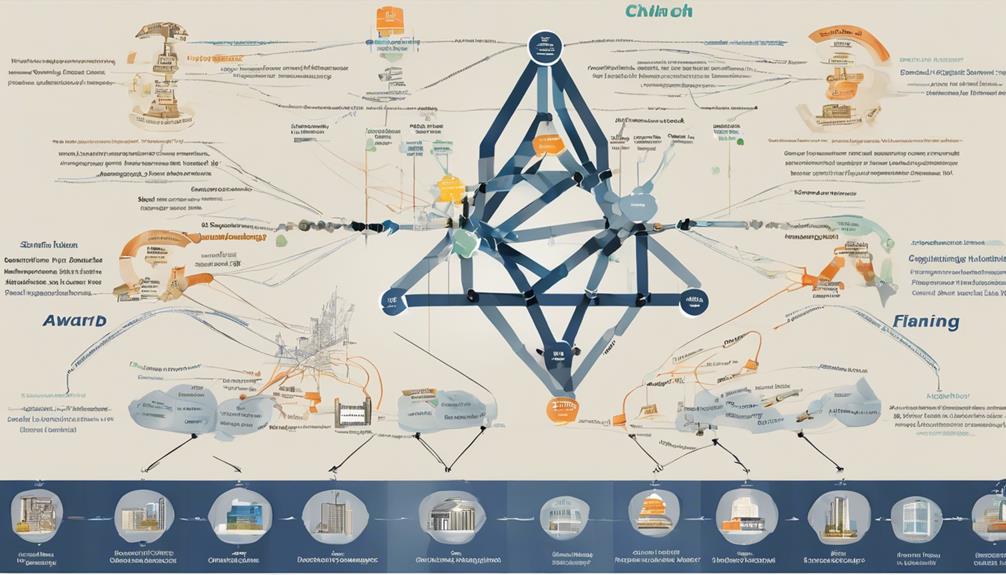Understanding Forward Mergers

Forward mergers involve one company absorbing another company, with the acquiring company becoming the parent and the acquired company becoming a subsidiary. This type of merger can provide tax benefits to the acquiring company. However, it is important to note that forward mergers do not offer legal protections against the liabilities of the target company.
Understanding the key features, tax implications, regulatory considerations, and valuation aspects of forward mergers is crucial for successful M&A transactions.
When considering a forward merger, it is essential to address third-party concerns, such as stakeholders and regulatory bodies. Antitrust challenges may also arise, requiring careful navigation to ensure compliance with competition laws. Additionally, exploring different financing options to fund the merger is a critical aspect of the planning process.
Analyzing case studies of organizations that have implemented forward mergers can offer valuable insights into how to leverage this M&A strategy to drive growth and create synergies. By examining real-world examples, companies can learn from both successful and unsuccessful mergers to inform their own strategic decisions.
In conclusion, understanding the nuances of forward mergers is key to maximizing the benefits and mitigating the risks associated with this type of M&A transaction. By carefully considering the various aspects of forward mergers, companies can position themselves for success in the competitive business landscape.
Key Takeaways
- Forward mergers involve the direct absorption of the target company by the acquiring company, making the buyer the parent and the target the subsidiary.
- These mergers are typically taxed as asset acquisitions, offering tax advantages, but they do not provide legal protections against the target company’s liabilities.
- When considering forward mergers, it is crucial to address third-party concerns, obtain regulatory approvals, conduct thorough due diligence, and secure shareholder approval.
- Valuation aspects of forward mergers include assessing discounted cash flow, evaluating synergy potential, and addressing antitrust issues to ensure a fair and equitable process.
- Financing options for forward mergers encompass debt and equity strategies, each impacting tax treatment and necessitating approval from the board of directors.
Defining Forward Mergers
A forward merger occurs when the buyer company directly absorbs the target company, leading to the target’s cessation. This merger type simplifies integration as the buyer assumes all assets and liabilities of the target. However, a key disadvantage is that the buyer lacks legal protection against the target’s liabilities. Despite this drawback, the benefits of becoming the parent company to the target, which becomes a subsidiary, often outweigh the risks.
In the United States, forward mergers are taxed as asset acquisitions, offering potential tax advantages that make them an appealing option. Unlike indirect mergers, the forward merger process is streamlined, making the overall transaction more straightforward and efficient.
It is important for companies to carefully consider the advantages and disadvantages of a forward merger before proceeding. By strategically leveraging this merger type, companies can effectively achieve their growth and expansion objectives.
Key Features of Forward Mergers
When it comes to managing forward mergers, there are several distinctive features that set them apart from other types of mergers. One key aspect is that in forward mergers, the acquiring company absorbs the target company‘s assets and liabilities, effectively eliminating the target’s legal existence. This structural change is significant as it consolidates the two entities into one cohesive unit.
Another important feature of forward mergers is the option to structure them as triangular mergers. In a triangular merger, the acquiring company uses a subsidiary or shell company to acquire the target, rather than doing so directly. This approach offers a range of benefits, including enhanced legal protections for the buyer. By operating through a subsidiary, the buyer can shield itself from certain legal risks that might arise from the acquisition.
Furthermore, triangular mergers provide a level of flexibility that may not be present in other merger structures. This flexibility allows for more intricate deal arrangements and strategic tax planning, which can be advantageous for both parties involved. Additionally, by allowing the target company to continue its operations as a subsidiary, triangular mergers offer a sense of continuity that can be beneficial for maintaining existing business relationships and operations.
Preserving the target company’s brand and identity is another advantage of triangular mergers. By keeping the target’s brand intact within the subsidiary structure, the integration process can be smoother, and any potential conflicts related to brand identity can be minimized.
Understanding these unique features of forward mergers, particularly triangular mergers, is crucial for effectively managing the complexities of such transactions and ensuring that all parties involved can reap the maximum benefits.
Tax Implications of Forward Mergers

Forward mergers involve the acquisition of a target company by another company, resulting in important tax implications that can affect the financial outcome of the transaction. The tax treatment in forward mergers is typically based on asset acquisitions, which can have a significant impact on the overall tax profile of the combined entity.
During a forward merger, the assets of the target company are transferred to the acquiring company. This transfer results in a step-up in the tax basis of the acquired assets, which can provide tax benefits for the buyer. Additionally, any potential tax liabilities associated with the target company are also transferred to the acquiring company. Conducting thorough due diligence is essential to identify and address these liabilities effectively.
In some cases, forward triangular mergers may be utilized, where the acquiring company’s subsidiary merges with the target company. This structure can offer additional tax planning opportunities and help optimize the overall tax efficiency of the transaction. By carefully considering the tax implications of different merger structures, companies can potentially enhance the financial benefits of the deal.
Furthermore, the utilization of the target company’s existing tax attributes, such as net operating losses, can further enhance the post-merger tax profile of the combined entity. By leveraging these tax attributes, companies can potentially reduce their overall tax burden and improve their financial performance following the merger.
Successfully navigating the complex tax landscape of forward mergers requires a comprehensive understanding of the relevant regulations and a strategic approach to maximizing the financial benefits of the transaction. By carefully considering the tax implications and structuring the merger appropriately, companies can optimize their tax position and create value for all stakeholders involved.
Third-Party Concerns in Forward Mergers
Forward mergers come with their fair share of advantages, but it’s crucial to consider the potential concerns involving third parties that may arise during the deal. These concerns often center around issues related to anti-assignment clauses and the necessity of obtaining consents from third parties.
In the realm of forward mergers, anti-assignment issues tend to be more prevalent, potentially causing hurdles and delays in the transaction process. This is mainly due to the stricter clauses that may restrict the transfer of contracts or agreements without explicit consent.
Additionally, in forward mergers, there’s a higher likelihood of needing third-party consents, which can further complicate the deal and require additional negotiation efforts. These consents are essential for ensuring that all parties involved are on board with the merger and its implications.
Compared to reverse triangular mergers, forward mergers generally offer lower levels of buyer protection, making it crucial for buyers to navigate potential third-party concerns with caution. Understanding these nuances is key to successfully addressing and resolving any issues that may arise during the M&A process.
Regulatory Considerations in Forward Mergers

In addition to the concerns involving third parties in forward mergers, it’s crucial to consider the regulatory environment in which these transactions take place. Understanding the regulatory landscape is essential for ensuring a seamless and legally compliant merger process.
Regulatory requirements in forward mergers encompass adherence to antitrust laws and obtaining approvals from regulatory bodies such as the Securities and Exchange Commission (SEC). Antitrust authorities scrutinize these mergers to prevent practices that could harm competition in the market. Non-compliance with these regulations can lead to legal repercussions and impede the merger process.
Key regulatory considerations in forward mergers include:
- Ensuring compliance with antitrust laws to uphold a competitive market environment
- Securing necessary approvals from regulatory entities like the SEC for specific transactions
- Familiarizing oneself with the industry-specific compliance requirements and regulations in the relevant jurisdictions
- Proactively addressing any potential regulatory issues to facilitate a smooth merger process.
Structuring a Forward Merger Transaction
Structuring a forward merger transaction involves careful consideration of various factors to ensure a smooth and successful integration. One crucial element is utilizing a subsidiary or shell company to acquire the target, a strategy known as a forward triangular merger. This approach provides buyers with valuable protection from the liabilities of the target company, which is essential when acquiring a new business entity.
When structuring a forward merger, it’s important to understand that the tax treatment can vary significantly between forward mergers, forward triangular mergers, and reverse triangular mergers. Therefore, it’s essential to analyze the potential tax benefits and implications of each structure thoroughly.
Addressing third-party issues, such as obtaining necessary consents and fulfilling contractual obligations, can also impact the transaction flow and should be proactively managed.
Due Diligence in Forward Mergers

Thorough due diligence plays a critical role in the success of a forward merger. It helps us identify potential risks and ensures that the merger aligns with our strategic objectives. Examining the target company’s financial records, operational processes, and legal status is essential for a seamless integration.
Researching industry reports and legal databases can offer valuable insights into the tax implications of the merger structure. This information is crucial for making informed decisions and avoiding unexpected financial consequences.
Addressing third-party issues, such as obtaining consent from customers or suppliers, is vital to prevent any obstacles during the merger process. By proactively dealing with these matters, we can streamline the integration and reduce the chances of disruptions.
Understanding the nuances of forward mergers, including the distinctions between forward mergers and forward triangular mergers, allows us to navigate the complexities of the transaction with confidence. This knowledge empowers us to make strategic choices and mitigate potential challenges that may arise.
Collaborating with experienced professionals, like attorneys and financial advisors, enhances our due diligence efforts and ensures that we’ve thoroughly assessed all aspects of the merger. Their expertise can provide valuable guidance and support throughout the process, helping us make well-informed decisions and maximize the benefits of the merger.
Shareholder Approval in Forward Mergers
Let’s dive into the crucial role of shareholder approval in forward mergers. Shareholders, who own a part of the company, are usually granted voting rights based on their ownership stake. For a forward merger to proceed, the company must secure majority approval from its shareholders. This process is governed by state laws and the company’s bylaws, ensuring a fair decision-making process.
To facilitate the shareholder approval process, companies often utilize proxy statements. These statements serve as a means to communicate essential information about the merger to shareholders and to request their votes. Through proxy statements, shareholders can make informed decisions regarding the merger based on the details provided.
In the realm of forward mergers, obtaining shareholder approval is a critical step that ensures transparency and accountability in the decision-making process. By involving shareholders in the decision-making process, companies can demonstrate their commitment to corporate governance and stakeholder engagement. Ultimately, shareholder approval in forward mergers plays a significant role in shaping the future direction of the combined entity.
Shareholder Voting Requirement
Shareholder approval plays a crucial role in forward mergers by ensuring that investors have a say in significant corporate decisions that could impact their investments. This approval process promotes transparency and adheres to established corporate governance standards, safeguarding the interests of all stakeholders involved.
The specific percentage of shareholder approval required can vary based on the company’s bylaws and state regulations. Nonetheless, the necessity for this approval is consistent, highlighting the importance of obtaining consent from those with a vested interest in the company’s future.
Shareholder voting empowers investors to influence the company’s trajectory, fostering a sense of ownership and engagement. Securing sufficient shareholder approval is essential to mitigate legal challenges and avoid delays that could hinder the merger process. Through active participation in the voting process, shareholders demonstrate their dedication to the company’s growth and long-term prosperity.
Transparent and inclusive shareholder voting practices uphold the principles of sound corporate governance, reinforcing investor trust in the organization. Ultimately, the shareholder voting requirement in forward mergers acts as a vital safeguard that upholds the democratic nature of corporate decision-making, ensuring that the interests of all stakeholders are considered and represented.
Disclosures for Approval
To gain shareholder approval for a forward merger, it’s crucial to provide comprehensive disclosures outlining the financial impacts and potential risks associated with the transaction. Detailed proxy statements serve as a vital tool in conveying the specifics of the merger to shareholders, enabling them to make well-informed decisions.
These disclosures must cover a broad array of factors, ranging from the strategic reasoning behind the merger to the anticipated financial outcomes and any foreseeable obstacles. By maintaining transparency and meeting regulatory obligations, we can establish trust and showcase our dedication to fairness throughout the merger process.
Insufficient disclosures can leave us vulnerable to legal disputes and delays, jeopardizing the efficiency and success of the merger.
As we navigate the intricacies of a forward merger, consistent and clear communication with shareholders is paramount. By prioritizing innovation and upholding the highest standards of corporate governance, we can obtain the necessary approvals and propel the business forward.
Majority Approval Threshold
In forward mergers, the majority approval threshold for shareholder support typically exceeds 50% of the company’s outstanding shares, ensuring that a significant portion of the ownership backs the merger decision. This high requirement for shareholder approval is crucial to safeguard the interests of minority shareholders by necessitating broad-based support for the transaction.
The majority approval threshold in forward mergers serves several essential purposes:
- It confirms that the merger has the endorsement of a substantial majority of the company’s owners.
- It guarantees that the decision is in line with the collective will of the shareholder base.
- It prevents a small faction from imposing a merger against the preferences of a larger portion of the ownership.
- It upholds the principle of majority rule, which is fundamental in corporate governance.
Reaching this majority approval threshold is a pivotal step in the forward merger process, indicating that the transaction has obtained the requisite shareholder support to proceed.
Post-Merger Integration Challenges

When companies decide to merge, they often face the challenge of integrating their operations smoothly. Bringing two organizations together involves aligning their cultures, systems, and processes. It’s crucial to overcome obstacles like communication breakdowns, employee resistance, and leadership conflicts to ensure a successful merger.
One common type of merger is a forward merger, where one company merges with and absorbs another. This type of merger can present unique integration challenges, as the acquiring company must take on the responsibility of blending the two organizations effectively. By setting clear goals, planning ahead, and managing change proactively, companies can navigate the complexities of a forward merger.
During the integration process, maintaining business continuity is essential. This means managing the expectations of both customers and employees to ensure a seamless transition. Addressing cultural differences, retaining key talent, and standardizing operations are top priorities that require careful attention and strategic planning.
Accounting Considerations in Forward Mergers
In a forward merger, it’s crucial to accurately allocate the purchase price to identify assets and liabilities at their fair values. This allocation directly impacts the financial statements of the merged entity, including the recognition of goodwill and other intangible assets.
Valuing acquired assets and assumed liabilities correctly is essential for determining the proper distribution of the purchase price. By carefully assessing fair values, the financial position of the merged entity can be accurately portrayed, providing stakeholders with a clear picture of the new organization.
Proper accounting treatment in a forward merger, such as a forward triangular merger, is vital for maintaining transparency and avoiding potential misrepresentations. Addressing accounting considerations diligently ensures the successful integration of the target company and the accurate reporting of the merged entity’s financial performance.
Valuation Aspects of Forward Mergers

In forward mergers, the valuation process is crucial. It involves using techniques such as discounted cash flow analysis to determine the target company’s value.
Additionally, assessing the synergies between the merging entities is vital as it can significantly impact the valuation. The goal is to reach a fair and equitable assessment of the companies’ fair market values.
This rigorous valuation work is necessary to establish the appropriate exchange ratio or purchase price in a forward merger transaction.
Discounted Cash Flow Analysis
Discounted Cash Flow Analysis is a valuable tool we rely on to evaluate the financial feasibility of forward mergers. By projecting the future cash flows of a target company and discounting them to their present value, we can establish a quantitative basis for determining its worth. This thorough analysis takes into account factors such as the discount rate and terminal value, giving us a data-driven perspective on the intrinsic value of the target company.
Utilizing Discounted Cash Flow Analysis allows us to make well-informed decisions, reducing the risk of paying too much for a merger target. This method of valuation helps us pinpoint attractive investment opportunities that align with our objective of fostering sustainable growth. By gaining insight into a company’s potential future cash flows, we can negotiate terms confidently in a forward merger that benefit both parties.
In our due diligence process, Discounted Cash Flow Analysis is a fundamental component that ensures we approach forward mergers strategically, maximizing shareholder value. This analytical approach equips us with the necessary insights to navigate the complexities of forward mergers and pursue opportunities that are in line with our long-term goals.
Synergy Evaluation
In addition to Discounted Cash Flow Analysis, we also consider the synergies that a forward merger can unlock to determine its complete value potential. Evaluating synergies is crucial in the valuation process as it examines the combined company’s capability to achieve greater efficiency and profitability.
We concentrate on three main areas: cost savings, revenue growth, and overall financial advantages.
Cost Savings entail reducing redundant operations, consolidating services, and streamlining functions, leading to enhanced operating margins.
Revenue Enhancement involves seizing cross-selling opportunities, expanding market presence, and enriching product/service offerings, resulting in accelerated growth and expanded market share.
Financial Benefits encompass improved capital access, risk diversification, and tax efficiency, leading to a stronger financial position and increased shareholder value.
Understanding these synergies significantly impacts our decision-making and integration strategies post-merger, ensuring the strategic rationale behind the forward merger is fully realized.
Antitrust Concerns in Forward Mergers
Antitrust regulators thoroughly analyze forward mergers to assess potential risks of market dominance by the combined entity. Recognizing the importance of maintaining a competitive environment that benefits consumers, these concerns are valid and must be addressed.
Factors that play a crucial role in this antitrust review include the combined market share of the merging parties and its impact on competition, the ability of remaining competitors to limit the merged firm’s pricing and output decisions, and the potential for the merger to strengthen the new entity’s bargaining power with customers and suppliers.
Horizontal and vertical mergers can present unique antitrust challenges that regulators need to carefully consider. To alleviate these concerns, companies may suggest remedies like divestitures or behavioral adjustments.
The ultimate aim throughout this process is to facilitate mergers that drive innovation, enhance consumer welfare, and adhere to antitrust regulations.
Financing Options for Forward Mergers

When considering the financing options for forward mergers, it’s important to look at both debt and equity strategies. Cash and stock combinations are frequently used in these situations, but deals that rely heavily on stock for financing can have implications for tax treatment. It’s crucial to get the board of directors’ approval to determine the most appropriate financing structure that will support the successful completion of the merger.
Forward mergers typically involve one company acquiring another company in the same industry or a related market. This type of merger allows the acquiring company to expand its market share, diversify its product offerings, or enter new markets. By combining resources and expertise, forward mergers can create synergies that benefit both companies involved.
In the realm of mergers and acquisitions, forward mergers are seen as a strategic move to drive growth and increase competitive advantage. Companies often opt for forward mergers to achieve economies of scale, access new technologies, or enhance their market positioning. It’s essential for companies to carefully consider their financing options when pursuing a forward merger to ensure a smooth and successful integration process.
Overall, the financing structure chosen for a forward merger can significantly impact the outcome of the deal. By carefully evaluating the mix of cash and stock, as well as considering the implications for tax treatment, companies can set themselves up for a successful merger.
Collaboration between the board of directors and financial advisors is key in determining the best financing approach that aligns with the strategic goals of the merger.
Debt Financing Considerations
Debt financing can be a smart choice for funding forward mergers. It lets us use the target company’s assets and cash flow to get the capital we need. Common sources of debt financing include bank loans, bonds, and lines of credit.
These debt financing options have key advantages:
- Tax benefits: Interest payments on debt financing are tax-deductible, which lowers the overall cost of the merger.
- Deal flexibility: Debt financing gives us more freedom to structure the deal compared to equity financing.
- Ownership preservation: With debt financing, we can acquire the target company without decreasing our current ownership.
It’s crucial to assess the target company’s assets and cash flow when considering debt financing. We must ensure that the target’s financial health can handle the extra debt and that the merger will generate enough cash flow to cover the debt payments.
Equity Financing Strategies
Equity financing can play a crucial role in funding forward mergers by offering strategic advantages. One effective strategy is issuing new company stock to finance the acquisition, which helps in maintaining liquidity throughout the merger process. Potential investors will carefully evaluate the impact on stock value and ownership structure, so it’s vital to analyze the potential dilution effect on existing shareholders’ ownership stake.
Preserving cash flow is a significant advantage of utilizing equity financing in forward mergers. By using stock instead of cash for the transaction, companies can avoid depleting their financial resources and ensure smooth operations post-merger. This flexibility becomes especially beneficial when dealing with a target company with a high valuation or when a more creative deal structure is necessary.
Moreover, equity financing can serve as a strong signal of confidence in the future prospects of the merged entity, potentially bolstering investor confidence and driving up the stock price.
When navigating the complexities of a forward merger, thoughtful equity financing strategies can be instrumental in achieving the desired strategic outcomes.
Case Studies of Successful Forward Mergers
In the realm of forward mergers, we’ve seen some standout examples that highlight their strategic significance. One notable case is the acquisition of Company X by Conglomerate Y, illustrating the smooth integration and synergies that a forward merger can bring.
The legal safeguards provided by the forward triangular structure enabled Conglomerate Y to navigate the acquisition intricacies efficiently, shielding it from potential liabilities. This structure also facilitated a seamless consolidation process, minimizing disruptions and ensuring a swift transition.
Additionally, the consolidation of operations and the removal of redundancies resulted in significant cost savings for Conglomerate Y, boosting its profitability and sharpening its competitive edge in the market. The streamlined operations allowed for a more agile and efficient business model, driving growth and enhancing overall performance.
Moreover, the combined expertise and resources of both entities fostered the creation of innovative products and services that met the changing needs of customers. This collaborative approach led to the development of cutting-edge solutions and a broader market reach, strengthening the market position of Conglomerate Y.
Ultimately, shareholders on both sides reaped the benefits of the forward merger, with Conglomerate Y’s stock price surging and Company X’s investors realizing attractive valuations and growth prospects.
This successful case study highlights the immense potential of forward mergers in unlocking value and driving sustainable growth for companies in today’s dynamic business landscape.
Frequently Asked Questions
What Is Forward Merging?
In a forward merger, two separate entities come together to form a unified and seamless organization. This process involves combining resources, expertise, and capabilities to create a more powerful and efficient entity. Strategic acquisition considerations play a crucial role in the decision-making process, as companies aim to achieve synergistic integration and unlock new growth opportunities.
The scalability implications of a forward merger are significant, as it can enable the newly formed entity to expand its operations and reach a larger customer base. By leveraging the strengths of both organizations, leaders can drive innovation and drive sustainable growth. Additionally, cross-selling opportunities may arise from the merger, allowing the company to offer a wider range of products or services to customers.
What Is the 80 Rule for Mergers?
We apply the 80% rule to optimize merger-related tax benefits, streamline the integration process, and navigate shareholder approval considerations. This rule helps us develop innovative acquisition financing strategies to drive growth effectively.
One type of merger that benefits from the 80% rule is a forward merger. In a forward merger, one company merges with and absorbs another company. This type of merger allows the acquiring company to benefit from the assets, resources, and market presence of the target company. By following the 80% rule, companies can ensure that the merger is structured in a way that maximizes the benefits for both parties involved.
Forward mergers are common in industries where consolidation and synergies can lead to increased competitiveness and market share. By leveraging the 80% rule, companies can ensure that the merger process is efficient and effective, leading to a successful integration of the two entities.
What Is the Difference Between a Forward and Reverse Subsidiary Merger?
In a forward merger, the parent company absorbs the target company, completely integrating its identity and operations. This type of merger results in the target losing its independent status and becoming part of the parent company’s structure. Forward mergers are often chosen when the parent company aims to expand its market presence or diversify its product offerings.
On the other hand, in a reverse merger, the target company retains its identity and operates as a subsidiary of the parent company. This allows the target company to maintain some level of autonomy while still benefiting from the resources and support of the parent company. Reverse mergers are commonly used when the parent company wants to enter a new market or industry without fully integrating the target company into its existing operations.
The decision to pursue a forward or reverse merger has significant implications for the parent-subsidiary relationship and the overall organizational structure. Forward mergers tend to lead to a more centralized and streamlined operation, with the target company fully integrated into the parent company’s culture and processes. On the other hand, reverse mergers allow for more flexibility and independence for the target company, potentially fostering a culture of innovation and entrepreneurship within the subsidiary.
Ultimately, the choice between a forward and reverse merger depends on the strategic goals of the companies involved and their desired outcome for the merger. Both types of mergers offer unique opportunities for corporate growth and innovation, and careful consideration of the implications of each approach is essential for a successful integration.
What Happens When a Subsidiary Merger With a Parent Company?
When a subsidiary merges with its parent company, we ensure a seamless integration that fosters growth and innovation for all involved parties. By structuring the transaction meticulously and upholding regulatory compliance, we pave the way for a smooth post-merger integration process. This type of merger, known as a forward merger, allows for a consolidation of resources and expertise, leading to enhanced operational efficiency and competitive advantage in the market.
Forward mergers involve the merging of a subsidiary into its parent company, creating a unified entity that leverages the strengths of both organizations. This strategic move can result in cost savings, increased market share, and improved overall performance. By aligning the goals and strategies of the subsidiary with those of the parent company, the merger can drive synergies and unlock new opportunities for growth and expansion.
Through careful planning and execution, we ensure that the merger process is carried out seamlessly, with a focus on maximizing value for shareholders and stakeholders. By combining the unique capabilities and assets of both the subsidiary and the parent company, we create a stronger and more competitive entity that is well-positioned for future success. Ultimately, a well-executed forward merger can lead to sustainable growth, increased profitability, and enhanced shareholder value.
Conclusion
We’re diving into the world of forward mergers, exploring its intricate details, including different types and structures. Forward mergers involve the merging of two companies where the target company is absorbed by the acquiring company. This type of merger allows the acquiring company to expand its market presence, diversify its product offerings, and achieve economies of scale.
One common type of forward merger is the horizontal merger, where two companies in the same industry and at the same stage of the production process come together. This type of merger can lead to cost savings, increased market power, and enhanced competitiveness in the industry.
Another type is the vertical merger, where a company merges with a supplier or distributor along its supply chain. Vertical mergers can streamline operations, reduce costs, and improve efficiency in the production process.
Regardless of the type, forward mergers require careful planning, thorough due diligence, and effective communication with all stakeholders. By considering factors such as valuation, regulatory compliance, and integration strategies, companies can navigate the complexities of forward mergers and unlock their full potential for growth and success.





